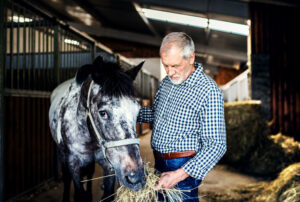As  horses get older, their needs change. Just like we modify our living spaces to ensure the comfort of our elderly family members, it’s crucial to adjust the living spaces of our senior equine friends to meet their changing needs.
horses get older, their needs change. Just like we modify our living spaces to ensure the comfort of our elderly family members, it’s crucial to adjust the living spaces of our senior equine friends to meet their changing needs.
Here are some helpful tips on creating a comfortable and caring environment for your senior horses.
Assessing the Needs of Your Senior Horse
The first step in creating a comfortable living space for an aging horse is to understand its specific needs. Common age-related conditions in horses include arthritis, dental problems, and reduced vision or hearing. A veterinarian can provide valuable insights into the health of your senior horse and help you understand the adjustments that may be necessary.
Stable Adjustments for Comfort
Flooring Modifications
Senior horses benefit from thick rubber matting to reduce joint stress and enhance cushioning and support while preventing tripping and slipping.
Bedding Types
Ample, soft bedding can prevent sores and provide warmth. Use dust-free straw or shavings to prevent respiratory issues, which older horses are prone to.
Temperature Control
Maintain a stable and comfortable temperature in the living quarters of older horses. Proper ventilation during warmer months and insulation during the cold season is crucial.
Accessibility and Mobility
Design for Easy Access
Make sure that entryways are easy for your senior horse to navigate. Install ramps with non-slip surfaces to aid horses with limited mobility if necessary.
Adjust Feeders and Water Troughs
Elevate feeders and water troughs to a comfortable height to prevent strain on the neck and back, making eating and drinking easier for horses with stiffness or dental issues.
Social Interaction and Mental Health
Social Contact
Maintaining social contact is crucial for your horse’s mental and emotional well-being. If possible, ensure your horse can see and interact with other horses to provide companionship.
Visual Stimulation
Allowing your horse to look outside and see different stimuli can help keep their minds active and reduce feelings of isolation.
Toys and Activities
Introduce stimulating toys like hanging feeders or food puzzles to encourage movement and mental engagement, which can help maintain cognitive function.
Outdoor Accommodations
Tailored Turnout Areas
Provide turnout areas that allow for gentle exercise without the risk of injury. Soft ground cover and secure footing are essential to encourage mobility while preventing falls.
Senior Horse-Friendly Shelter
Outdoor shelters should be easy for older horses to enter and exit and provide protection from the elements.
Safety First
Inspect fences and gates regularly to ensure they are secure and free from sharp edges or protrusions that could cause injury.
Regular Maintenance and Upkeep
A clean and well-maintained environment is essential for the health of senior horses. Regular cleaning prevents dust and mold buildup; timely repairs keep the stable, safe, and functional.
Providing senior horses with a comfortable living space requires close attention to detail and a thorough understanding of their needs. Properly designing their environment can significantly improve their quality of life during their golden years, ensuring that they live out their days in comfort and dignity.
For those seeking to provide the ultimate care for their senior equines, consider the benefits of a custom-built horse barn or run-in shed from Deer Creek Structures! These structures offer a perfect combination of safety, convenience, and comfort.
Explore our range of customizable options to ensure we design a structure with your senior horse’s well-being in mind—call (254)546-2276 with any questions regarding our services.
Your beloved companion deserves the best, and a custom-built horse structure can provide just that!
